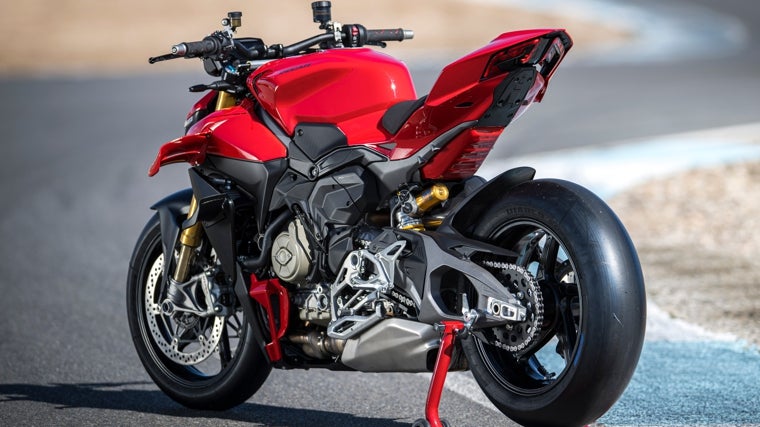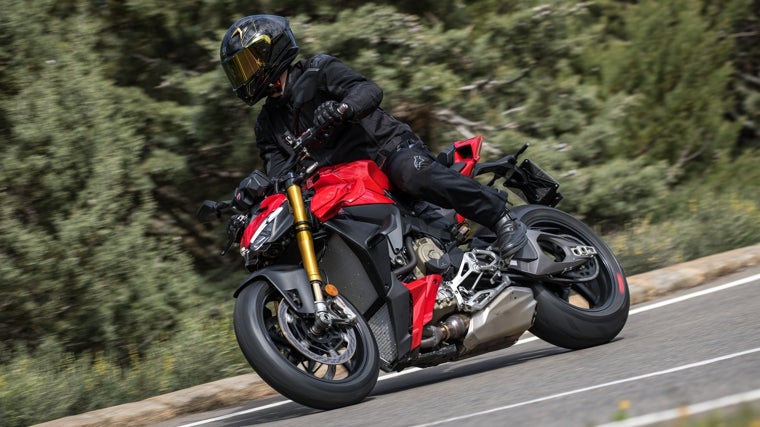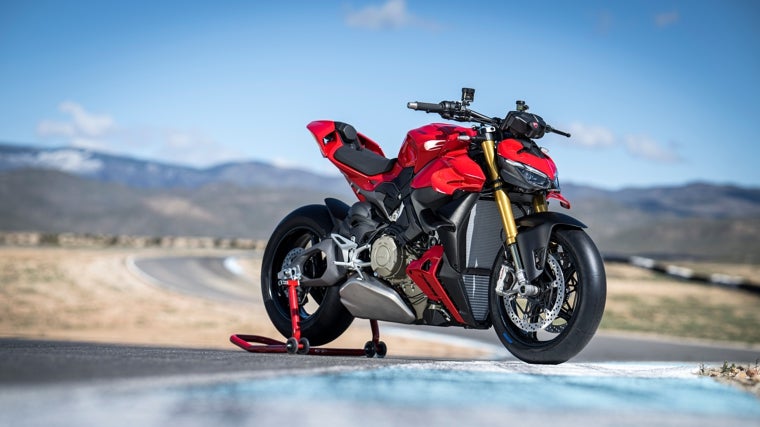New Ducati Streetfighter V4 S: Riding the Wonderland Hypernaked

The new Ducati Streetfighter V4 is a "rib" of the Panigale V4, the seventh generation of Borgo Panigale superbikes, from which it inherits the same chassis and electronics. And just like its faired twin, the Italian hypernaked bike's ultimate goal is lap time, absolute performance , and everything that contributes to reducing even a few thousandths of a second on the stopwatch has been implemented. Cutting-edge technology, born to win the MotoGP World Championship, has been sensibly transferred first to a sports bike and, later, to this naked bike capable of combining high racing performance with the comfort of a road bike.
The design is clearly Streetfighter; there have been no redesigns, and it maintains the hallmarks of the previous generation: a motorcycle without a fairing, with a menacing look and muscular lines that generate strong emotions even before turning it on . Of course, it's a bike for "adult" riders, expert pilots who can squeeze out its enormous potential. Although in reality, as we saw at its presentation in Almería, it has certain electronic doses of docility inside that allow you to enjoy it even if you're not Marc Márquez.
The full-LED headlight has been reworked, and at the rear, the headlights are also full-LED, with the double-C shape that characterizes the sportiest Ducatis. Of course, amidst this testosterone-powered aesthetic, what most catches the eye are the biplane front fins, those spectacular wings that are now even more efficient : 45 kg of downforce at 270 km/h (+17 kg compared to its predecessor) and 30 kg at 220 km/h, a technical solution for the track that improves the bike's stability and precision.
It is powered by the Desmosedici Stradale engine , with the same configuration as the Panigale, a 1,103 cc 90° V4 with desmodromic valve timing, counter-rotating crankshaft and Twin Pulse distribution. This Euro5+ approved engine delivers a whopping 214 hp at 13,500 rpm (with the Akrapovič exhaust it reaches 226 hp), that is, just 2 hp less than its sports sister - due to differences in the intake. Its maximum torque is 12.2 kgm at 11,250 rpm. Compared to the previous version of the Streetfighter, it has gained 6 hp and lost 2 kilos (-4 kg if we go for the S version), now weighing just 191 kg. The S version, weighing 189 kg, has a power-to-weight ratio of 1.13 hp/kg, the best in its class.
It also shares a chassis with the new Panigale V4, with the engine as the bike's structural element. In this version, the front frame is lighter (3.47 kg compared to the previous 4.42 kg) and stiffer (down 39% laterally) to offer greater confidence when leaning and greater efficiency in apex landing and maintaining the trajectory. The swingarm is also the same, a symmetrical hollow double-arm, lighter and with greater lateral stiffness.
The Streetfighter V4 S features forged aluminum alloy wheels with five tangential spokes, inspired by those of the DesmosediciGP, and the suspension is third-generation electronically controlled Öhlins NIX/TTX (multi-adjustable 43 mm Showa on the standard V4). It features lighter Brembo Hypure front brake calipers with improved heat dispersion. It also features the innovative Race eCBS system with Cornering functionality, developed in collaboration with Bosch, which is capable of activating and modulating the rear brake during braking even when the rider only applies the front brake. The system offers five levels compared to the three of the previous model.
 Ducati Streetfighter V4 S
Ducati Press
Ducati Streetfighter V4 S
Ducati Press
In terms of ergonomics , thanks to the slightly higher and wider clip-on handlebars than the Panigale V4, the Streetfighter offers a fair amount of comfort for an ultra-sporty naked bike. Compared to the previous Streetfighter V4, it's slightly more comfortable thanks to the handlebar curve that's been moved back 10 mm closer to the rider, and the footpegs are lower and forward, and positioned 10 mm further inboard.
Regarding the electronics package , we'd sooner say what it doesn't have. This new Streetfighter V4 is equipped with: Ducati Traction Control DVO, Ducati Slide Control, Ducati Wheelie Control DVO, Ducati Power Launch DVO, Engine Brake Control and Ducati Quick Shift 2.0. It also features Ducati Vehicle Observer, an algorithm developed by Ducati Corse in MotoGP, which simulates the input of more than 70 sensors, thus perfecting the electronic control strategies, allowing the controls to intervene in an almost predictive manner to adapt to the rider's needs in the search for maximum performance.
The new 6.9" full-TFT instrumentation with 8:3 resolution offers differentiated views (Infomode) for use on the road or on the track, and reports on a multitude of functions beyond the usual ones, such as TPMS, instantaneous engine torque and power output, lateral and longitudinal acceleration values, instantaneous lean angles and accelerator and brake input.
 Ducati Streetfighter V4 S
Ducati Press
Ducati Streetfighter V4 S
Ducati Press
Testing
Ducati organized a test drive on the roads of Almería, without including a track test, so we were actually able to explore less than half of the potential of this new Streetfighter V4, a blessedly crazy motorcycle whose natural habitat is more likely a race track. In reality, the unit we enjoyed was the S version , i.e., the standard version but equipped with Öhlins suspension and steering damper, forged wheels, and a lithium-ion battery. Both are offered in single-seat configuration, with a passenger kit available as an accessory.
Already underway, during the first few meters, cruising through an urban area between traffic lights—the stage before the winding road—the slightest hints of throttle input already make it clear that this bike holds immeasurable fury within it, a horsepower to be taken seriously , and with the need to unleash all those capabilities little by little. You have to get to know the Streetfighter gradually… It's the most powerful naked bike on the market and is capable of delivering performance and features from another universe.
 Ducati Streetfighter V4 S
Ducati Press
Ducati Streetfighter V4 S
Ducati Press
But it must also be said that Ducati has prepared impressive electronics to control those 214 hp, and on the road, the Streetfighter V4 isn't as overwhelming as we thought. It's even a friendly bike. It delivers its enormous torque progressively , and acceleration is as powerful as it is manageable. The engine pushes in any range, in any gear, from very low revs, and with a very linear power delivery.
The gear ratio is a little shorter than on the Panigale V4, so there's less sense in stretching the gears on this bike. The suspension works outstandingly, and the brakes have a powerful, controllable feel. The third-generation electronically controlled Öhlins NIX/TTX suspension has increased settings, allowing for more comfortable calibrations for road use. The suspension improves comfort when riding in relaxed mode, and when accelerating, you'll notice that the damper's first section of travel is reduced, optimizing weight transfer.
 Ducati Streetfighter V4 S
Ducati Press
Ducati Streetfighter V4 S
Ducati Press
Needless to say, the bike is a corner-eater, and its racing genetics are primarily intended to offer extremely precise line handling, as well as enormous agility and responsiveness. It carves lines incredibly smoothly, making it a very intuitive bike. Thanks to its chassis, it wasn't necessary to lengthen the swingarm on this model compared to the Panigale V4 to enhance stability. It was enough to work on the front chassis dimensions (+0.5° steering angle, +1 mm on the trail) to achieve the perfect balance between agility and stability.
Obviously, we tested the tip of this bike's electronic iceberg, as in open traffic, it's not necessary to activate almost anything it offers, as it's more geared toward the track. But you can feel the chip working hard. The bike is as efficient as possible, but it also inspires great confidence, precision, and comfort on the move. The focus has been on the rider, not on requiring a lot of skill to go fast on this bike, thanks to the electronics and engine.
Although the riding position is derived from the Panigale V4, the Streetfighter offers much more comfort, thanks to the slightly higher handlebars that straighten the back and greater roominess. It feels comfortable and the ergonomics don't fatigue, considering potential road routes, and offers good freedom of movement . The shape of the seat and its connection to the tank allows the rider to firmly anchor their knees for a good grip during hard braking, and this also helps reduce arm strain in the middle of a turn. On board, the bike always feels comfortable and is very easy to ride, and the exhaust note is somewhat more subdued than on the sports bike, which is appreciated if we want to use it on a daily basis.
ABC.es





